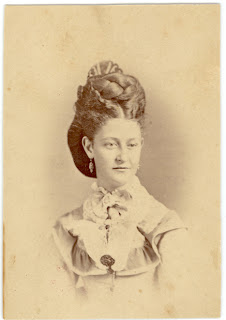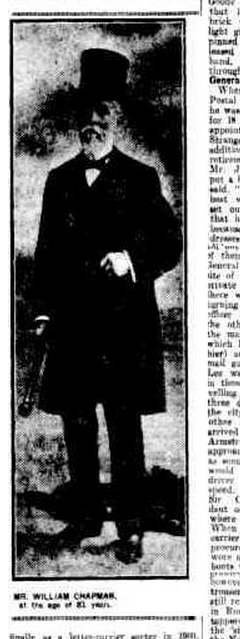William’s son George (my great, great grandfather) kept extensive diaries from 1872 to 1926.
Taylor, Betsy. George Chapman diaries [online].Southerly, Vol. 64, No. 3, 2004-2005: 32-53. Availability:<http://search.informit.com.au/documentSummary;dn=601281277926000;res=IELLCC>ISSN: 0038-3732. [cited 12 Jun 12].
THE LATE MR. WILLIAM CHAPMAN.
THE FUNERAL.
By the death of Mr. William Chapman the colony has lost one of its oldest colonists, one of its best musicians, and one of its most respected citizens. He was employed in the General Post Office for 39 years, and was known as the father of the postmen, while his great abilities, either as an instrumentalist or as leader of an orchestra earned for him a reputation of which any man might well feel proud. Therefore it was only to be expected that his funeral should have been largely attended on Sunday afternoon. The various musical organisations of the city were well represented, and a band of 33 was chosen from them under the conductorship of Mr. Heath to play the “Dead March in Saul.” A splendid effect was produced, the different instruments blending well, and almost the whole way from Angas street east, where the deceased gentleman’s late residence is situated, to the West-terrace cemetery, the band played the solemn strains.
On either side of the hearse marched the pallbearers, Messrs. John Lee, W. Mitchell, D. Mahony and J.W. Williams, and then came the mourning coaches, the members of the Adelaide Lodge of Oddfellows, of which Mr. Chapman was a member, Brothers A.J. Radford, R. Morphett, secretary, and R. Richardson, deputy provincial grand master, walking in front.
There was a large attendance of the general public. At the grave the Rev. A. Wilson read the burial service of the Unitarian Church, and Mr. Radford conducted the Oddfellows service.
The chief mourners were: Mr. and Mrs. William Chapman, Mr. and Mrs. George Chapman, Messrs. Charles, Alfred, Frank, Bernard, and Frederick Chapman (sons), George W. Chapman, Harry Chapman, H.M. Chapman, P.E. Chapman,and Harold Chapman (grandsons), Misses Mary Chapman and Hilda Chapman (granddaughters), E. Weller and Tom Weller (nephews), and Mr. and Mrs. John Patten.
The General Post Office and the suburban officers were represented by Messrs. A.J. Wright, (chief clerk), J. Conigrave, C.G. Schedlich. J. McDonald, J. O’Halloran, S. Boer, E.L. Virgo, W.H.Button, E. Bacon, S. Suckling, A.J. Arrowsmith, E. Niebuus, J. Mahoney, J. Lee, Mr. Black, A. Hubble, W.S. Doucit, J. Williams, W.A. Mitchell, J. Oatey, R. Gillman, V. Gurr, J. Moloney, W. Maley, John H. Maddern, E.J. Conlon, W. Condon, M. Collins, J.P. Pearson. J. Ottaway, P.F. Smith, S. Ramsay, S. Kidman, E. Short, A. Hamlin, H.B. Wilson, W.G. Wallace, and C. Graham.
The band was composed thus: — Eastern Suburban — Messrs. C. Schraeder, T. Stephens, S. Leaney, F. Stephens, J. Harrison, E.L. Gill, H. Hill, J. Shapter, C. Smith, J. Sullivan, W. Piercey, H. Coombes, A. Piercey, D. Pratten, J.J. Craig, and F. Grunicklee. Loco. — Messrs. J. Bermingham, W.Bermingham, S. Graves, K.J. Carne, W. Thorne, and W. Hooper.
Fitzgerald’s Circus — Messrs. F Bowles, A. Beane, C. Geyer, H. Bush, and T. Sexton.
Theatre Boyal orchestra —Messrs. F. Saltmarsh, J. Sparbier, and A. Heath.
South Australian Military — Messrs. F. Ingerson and J. Stephens.
The music profession was also represented by Messrs. A.C Quin, P.A Howells, James Shakespeare, C. Rosenbain, F. James, J.H. Fray, T. Grigg, and C. Cawthorne.
Among others at the grave were Messrs. James Lucas, F.F. Smith, M.W. Brooks, E.Everett, Mr. Shrosbee, James Perry, W.T. Oke, H.M. Addison, John Rowe, George Pullman, W. Nairne, C.W. Dyer, G. Beare, A. Warhurst, J.E. Gooden, H. Delaine, J.E. Kippist, J. Fabian, W. Collins, T. Smith, W. Lithgow, C. Molton, J. Williams, A Robertson, J.V. Duckmaster, R. Hutton, T. Tunstall, B. Earnshaw, S. Moore, B. Chapman, J. Fitzsimmons, R.C. Mitton, E. Bleumel, R.Buring, W.F. Giffen, C. Giffen, J. Foggo, William Gordon, B. Davis, A. Proctor, C. Williams, G. Hackett, C. Schrader, J.Duncan, A.E.P. Tomlin, C.G. Dibbin, J. McCabe, and. H. Barnett.
Wreaths were sent by the employees of the General Post-Office, Mrs. William Kay and the Misses Kay, Mr. Robert Kay and the Misses Kay, Mrs. Giffen and family, Mr.and Mrs. John Collins aud the Misses Collins, Mesdames M. McFie, C. Williams, O’Brien, Brooks, and May, Messrs. W. R. Pybus, and C. Cawthorne.
Apologies for non attendance were received from Sir Charles Todd, the Rev. J.C. Woods, and Mr. F. Basse (president of the Liendertafel). Messrs. Pengelley & Knabe carried out the funeral arrangements
This is the music which played throughout the funeral procession, The Dead March by Handel.









